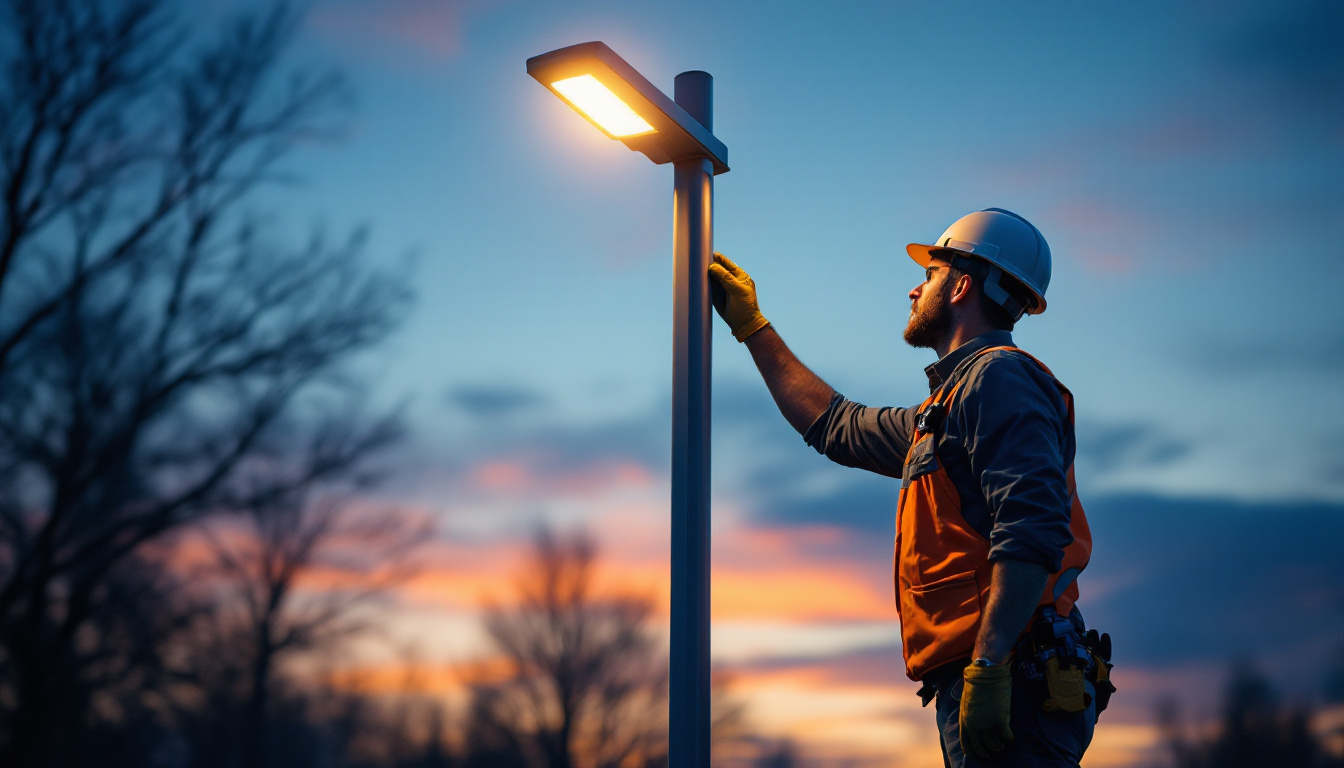
street lighting is a critical component of urban infrastructure, providing safety and security for pedestrians and drivers alike. For lighting contractors, ensuring the successful installation and maintenance of street post lights is paramount. However, various challenges can arise during these projects, often leading to delays, increased costs, and unsatisfied clients. This article will explore common issues faced by lighting contractors and offer practical strategies to avoid them.
Before delving into solutions, it is essential to recognize the typical issues that can occur during street lighting projects. These challenges can stem from various sources, including design flaws, environmental factors, and logistical hurdles.
One of the most prevalent issues in street lighting projects is design flaws. Poorly designed lighting plans can lead to inadequate illumination, resulting in dark spots that compromise safety. Additionally, improper placement of fixtures can create glare, which not only affects visibility but can also irritate nearby residents.
To mitigate these risks, it is crucial to conduct thorough site assessments before finalizing designs. Engaging with local stakeholders and utilizing advanced lighting design software can help ensure that the lighting plan meets both safety standards and community expectations. Furthermore, incorporating feedback from community members can provide valuable insights into specific areas of concern, allowing for a more tailored approach that enhances overall satisfaction with the project.
Environmental conditions can significantly impact the performance and longevity of street lights. Factors such as extreme weather, humidity, and pollution can lead to premature failures of lighting fixtures. For instance, coastal areas may experience corrosion due to saltwater exposure, while regions with heavy snowfall may require fixtures that can withstand the weight of accumulated snow.
Contractors should select materials and fixtures that are specifically designed for the local environment. Additionally, implementing regular maintenance schedules can help identify and address potential issues before they escalate. It’s also worth considering the use of energy-efficient LED technology, which not only reduces energy consumption but often has a longer lifespan, making it a more sustainable choice in challenging environments. This proactive approach ensures that street lighting remains functional and effective, even in the face of adverse conditions.
Logistics play a vital role in the timely completion of street lighting projects. Delays in the delivery of materials, equipment, or permits can lead to extended project timelines and increased costs. Moreover, coordinating with various stakeholders, such as utility companies and local governments, can complicate the process.
To streamline logistics, contractors should develop a detailed project timeline that includes all phases of the project, from procurement to installation. Establishing strong communication channels with suppliers and stakeholders can also help mitigate delays. Additionally, leveraging technology such as project management software can enhance coordination efforts, allowing for real-time updates and adjustments to the project plan as needed. This level of organization not only helps keep the project on track but also fosters a collaborative environment where all parties are informed and engaged throughout the process.
Implementing best practices is essential for lighting contractors to avoid common pitfalls associated with street lighting projects. By following proven strategies, contractors can enhance project efficiency and client satisfaction.
Before embarking on a street lighting project, conducting a comprehensive site assessment is vital. This assessment should include evaluating existing infrastructure, understanding traffic patterns, and identifying potential obstacles, such as trees or buildings that may obstruct light distribution.
Utilizing tools such as photometric analysis can provide valuable insights into how light will interact with the environment. This data can inform decisions about fixture placement, type, and wattage, ensuring optimal performance once installed. Additionally, it is important to consider the surrounding landscape and urban design elements, as these factors can significantly influence the effectiveness of the lighting. For instance, areas with heavy pedestrian traffic may require brighter, more focused lighting, while residential zones might benefit from softer, ambient illumination to create a welcoming atmosphere.
community engagement is an often-overlooked aspect of street lighting projects. Involving local residents and stakeholders in the planning process can lead to better outcomes and increased satisfaction. Community feedback can provide insights into specific lighting needs, such as areas that require additional illumination or preferences for fixture styles.
Hosting public meetings or surveys can facilitate this engagement. By fostering open communication, contractors can build trust and ensure that the final lighting solution aligns with community expectations. Furthermore, involving local artists or designers in the process can enhance the aesthetic appeal of the lighting installations, making them not just functional but also a point of pride for the community. This collaborative approach can lead to innovative designs that reflect the unique character of the neighborhood, ultimately fostering a sense of ownership among residents.
The longevity and performance of street lighting systems heavily depend on the quality of materials used. Investing in high-quality fixtures, poles, and wiring can reduce the likelihood of failures and maintenance issues in the long run. While the initial investment may be higher, the long-term savings from reduced repairs and replacements can be significant.
Contractors should prioritize sourcing materials from reputable manufacturers known for their durability and reliability. Additionally, considering energy-efficient options, such as LED fixtures, can provide further cost savings through reduced energy consumption. Beyond just energy efficiency, selecting materials that are resistant to weather conditions, such as corrosion or extreme temperatures, can extend the lifespan of the lighting systems. Moreover, incorporating smart technology, like adaptive lighting controls, can enhance energy savings and allow for real-time monitoring and adjustments based on environmental conditions, ensuring that the lighting remains effective and responsive to the needs of the area.
Even with the best planning and installation practices, ongoing maintenance is crucial for ensuring the longevity of street lighting systems. Implementing a proactive maintenance strategy can help identify and address issues before they escalate.
Regular inspections are essential for identifying potential problems with street lighting systems. Establishing a routine inspection schedule allows contractors to assess the condition of fixtures, poles, and wiring, ensuring that any issues are addressed promptly.
During inspections, contractors should check for signs of wear and tear, such as rust, corrosion, or damaged wiring. Additionally, verifying that all fixtures are functioning correctly can help maintain optimal illumination levels and prevent safety hazards. It is also beneficial to document the findings of each inspection, creating a comprehensive history that can inform future maintenance decisions and help prioritize repairs based on severity and urgency.
Creating a reporting system for maintenance issues can streamline the process of addressing problems as they arise. This system should allow community members, maintenance staff, and contractors to report issues easily, ensuring that no problem goes unnoticed.
Utilizing technology, such as mobile apps or online platforms, can facilitate this reporting process. By encouraging community involvement in reporting issues, contractors can enhance responsiveness and improve overall satisfaction. Furthermore, integrating a feedback loop where community members can receive updates on reported issues fosters a sense of ownership and accountability, ultimately strengthening the relationship between the community and maintenance providers.
Seasonal changes can present unique challenges for street lighting systems. For example, winter weather can lead to snow accumulation on fixtures, while summer storms may cause flooding or power outages. Planning for these seasonal challenges is essential for maintaining the functionality of street lights.
Contractors should consider implementing snow removal protocols for areas prone to heavy snowfall. Additionally, ensuring that fixtures are equipped with weather-resistant features can help mitigate damage from storms or extreme temperatures. It may also be prudent to conduct pre-season assessments to identify vulnerable areas that may require additional attention or reinforcement, such as installing protective barriers or enhancing drainage systems to prevent water damage. By anticipating these seasonal challenges, maintenance teams can ensure that street lighting remains reliable and effective throughout the year.
Advancements in technology have transformed the landscape of street lighting projects. By leveraging innovative solutions, contractors can enhance efficiency, reduce costs, and improve overall project outcomes.
Smart lighting technology has gained traction in recent years, offering numerous benefits for street lighting systems. These solutions allow for remote monitoring and control of lighting fixtures, enabling contractors to adjust brightness levels based on real-time conditions.
Implementing smart lighting can lead to energy savings, as lights can be dimmed or turned off during low-traffic periods. Additionally, these systems can provide valuable data on usage patterns, helping contractors make informed decisions about future upgrades or expansions.
Drones have emerged as a valuable tool for conducting site assessments in street lighting projects. These unmanned aerial vehicles can provide high-resolution aerial imagery, allowing contractors to assess large areas quickly and efficiently.
Using drones can enhance the accuracy of site assessments, enabling contractors to identify potential obstacles and plan for optimal fixture placement. Furthermore, drones can be used for inspections, reducing the need for manual checks and improving safety for maintenance crews.
Street lighting projects present unique challenges for lighting contractors, but with careful planning and execution, these issues can be effectively managed. By understanding common challenges, implementing best practices, and leveraging technology, contractors can enhance project outcomes and ensure client satisfaction.
Ultimately, the key to success lies in a proactive approach to design, installation, and maintenance. By prioritizing quality, community engagement, and innovative solutions, lighting contractors can navigate the complexities of street lighting projects and deliver exceptional results.
As urban areas continue to evolve, the demand for effective and efficient street lighting will only increase. By staying informed about industry trends and embracing new technologies, lighting contractors can position themselves as leaders in the field, ready to meet the challenges of tomorrow.
Ready to elevate your street lighting projects with superior quality and value? Look no further than LumenWholesale for all your lighting needs. Our spec-grade lighting products are designed to meet the highest industry standards, ensuring you deliver reliable and high-performance lighting solutions every time. Say goodbye to inflated markups and hello to unbeatable wholesale prices, plus enjoy the convenience of free shipping on bulk orders. Don’t compromise on quality or cost. Choose LumenWholesale and make your next project shine. Discover our extensive selection and experience the best in lighting by visiting Wholesale Lighting at the Best Value today.

Discover the ultimate lighting contractors’ checklist for selecting the best shop lights for your garage.

Discover essential insights and tips for lighting contractors in our latest article, “Light Post: Lighting Contractors Should Know.” From innovative design trends to energy-efficient solutions, equip yourself with the knowledge to illuminate spaces effectively and sustainably.

Discover how LED Edison string lights can revolutionize your lighting projects by enhancing efficiency and aesthetics.

Discover expert insights on choosing and installing LED four-foot tubes for lighting contractors.